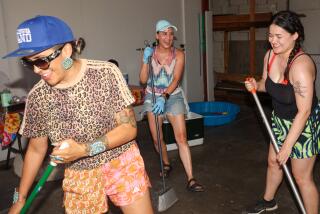An Indian Message That Carries a Punch Line : Stage: Spiderwoman Theatre celebrates its Native American heritage with stories and comedy that counter stereotypes.
It didn’t matter that Lisa Mayo was a classically trained singer.Or that she had studied with the redoubtable Uta Hagen. Or that her sister, Muriel Miguel, helped found the Open Theatre.
None of that mattered when it came to casting time. Like almost all nonwhite actors--even with the trend of non-traditional casting--the sisters were inevitably slotted into exotic roles. “The New York ethnic,” as Mayo terms it.
For the record:
12:00 a.m. Nov. 15, 1990 For the Record
Los Angeles Times Thursday November 15, 1990 Home Edition Calendar Part F Page 7 Column 1 Entertainment Desk 1 inches; 29 words Type of Material: Correction
Wrong tribe--The mother of Spiderwoman Theatre’s Lisa Mayo and Gloria and Muriel Miguel is a member of the Rappahannock tribe in Virginia. The wrong tribal affiliation was reported in Monday’s Calendar.
While there were many reasons for Lisa, Muriel and their other sister, Gloria, to form Spiderwoman Theatre in 1975--to explore and celebrate their American Indian roots, to be storytellers, to blend low comedy with high intentions--countering stereotypes was a crucial one.
Unlike many performing groups, Spiderwoman’s strategy for survival is itself the content of the performance. So their current show, “Winnetou’s Snake Oil Show From Wigwam City”--which marks their first visit to Los Angeles (Tuesday at Highways Performance Space in Santa Monica)--attempts a satiric overview of how past Indian stereotypes change into new, far subtler forms.
Once an ethnically diverse company of thirteen, Spiderwoman (named for the goddess of creation, a universal figure in American Indian tales) is now a quartet of the three sisters and Hortensia Colorado, a member of Mexico’s Chicimec Indians and a veteran of Chicago’s Goodman Theatre.
“Our original members started dropping out for various reasons,” Mayo explained by telephone from San Diego, where Spiderwoman performed Saturday at Centro Cultural de la Raza. “It was time to focus on Native American work.”
This was 1980, and it was just two years later, when the group toured Europe, that the concerns at the heart of “Winnetou” surfaced.
Item: Italians expressed amazement that these actresses were really Indians from Brooklyn, that their father was really from the Kuna Indians of Panama’s San Blas Island, that their mother was really from the Winnebago tribe of Upstate New York. “They thought that there were no Indians left,” Mayo recalled.
Item: A German woman introduced herself to the trio as a Sioux Indian. “She even adopted a Lakota name,” said Mayo. “I didn’t know whether to laugh or cry.”
Item: Repeatedly, Europeans asked the women if they knew about “the famous Winnetou,” supposedly a great North American Indian.
What was going on here? This Winnetou fellow was a complete mystery to the sisters, until they found out that he was the Indian hero in the novels of Karl May, a 19th Century German writer whose opus mythologizes an America he never visited. It also provides many Europeans with the only view they have of Indian life.
“But it wasn’t true about us. May wrote fiction, very idealistic and romantic, which concluded that we were a dying race. Well, we have something to say about that. All of our bones aren’t in the museum.”
While the show examines May’s mythical creations, it lampoons them as well. Comedy--especially the kind that liberally borrows from slapstick and vaudeville--is the stuff from which Spiderwoman spins its performance web. For Centro Cultural’s performing arts director Eloise De Leon, “as an audience member, I didn’t know what to expect from Native American women. The stereotype says that they’ll do solemn rituals, but they destroyed that idea the minute they came on. They’re zany. Kids have a great time with them.”
But comedy is nothing without targets, and “Winnetou” has a big one that Mayo calls “The Plastic Shaman.”
Unlike the plastic Jesus on a car dashboard, “plastic shamans” are very real: a lucrative group within the larger New Age spirituality movement. “Native elders have become very concerned with the trivialization of Indian rituals. There are weekend retreats to make you a shaman. We resent Lynn Andrews (the white author of several best-selling books on Native American spirituality), especially the way her books are placed alongside genuinely Native spiritual titles in bookstores.” Just as troubling for Spiderwoman Theatre is Sun Bear, an Indian man who has created his own tribe.
“When we did ‘Winnetou’ in Seattle last March, the reaction was mixed. Native audiences were very supportive. But white fans of Andrews or members of Sun Bear’s tribe criticized us for being too harsh. We told them that it takes years to become a shaman, that a medicine person never accepts money. It’s sad, because people are searching for a spiritual truth for themselves, and I feel for them. But they’re involved in things that can destroy our culture.”
“We all know that what makes us so funny,” Mayo reflected, “is an underlying set of hurts and scars and pain. You don’t hide it. You turn it into something new.”
More to Read
The biggest entertainment stories
Get our big stories about Hollywood, film, television, music, arts, culture and more right in your inbox as soon as they publish.
You may occasionally receive promotional content from the Los Angeles Times.










